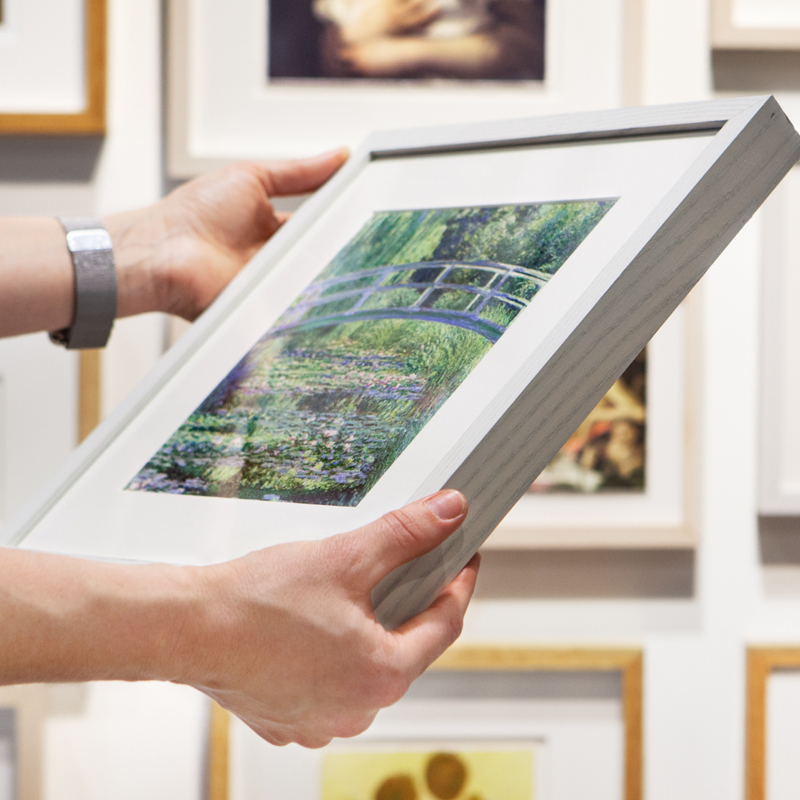Quinten Massys, 'An Old Woman ('The Ugly Duchess')', about 1513
About the work
Overview
This must be one of the most arresting faces in the National Gallery’s Collection. An elderly woman with lively eyes set deep in their sockets, a snub nose, wide nostrils, pimply skin, a hairy mole, bulging forehead and a prominent square chin rests one hand on a marble parapet. Her neck is rumpled by age and she seems to have lost all her teeth. She is elegantly and aristocratically dressed, although by the time this picture was painted her clothes would have been many decades out of date and her cleavage considered scandalous. She brazenly challenges every traditional canon of beauty and rule of propriety.
This painting is part of a pair: her ‘other half’ is in a private collection in New York. The old woman dons this flamboyant and provocative outfit in order to seduce the old man, to whom she offers a rosebud, a flower with sexual connotations. These are satirical portraits, mocking the vanity of the old who dress and behave as if they are still young. This painting captures the emergence of the grotesque (in the original sense of the word, denoting the surprising, unusual, and playful) as a subject for painting. Quinten Massys pioneered this type of secular, satirical imagery. A case of mistaken identity later earned her the nickname ‘The Ugly Duchess’.
Audio description
Listen to an audio description of Quinten Massys's 'An Old Woman'
Transcript
This is a description of the painting 'An Old Woman', also known as 'The Ugly Duchess', painted around 1513 by Quentin Massys. It is oil on canvas, just over 60 centimeters high and 45 wide, in a simple dark brown frame.
This detailed and vibrant portrait is of an elderly woman. It shows her from just above the waist up, wearing a substantial, elaborately embroidered horned headdress. Her remarkable face, with its extreme and unusual features, is set against a bright green background.
She is turned three-quarters of the way to the right, has small lively brown eyes focused intently on something high up to our right. Running along the bottom is a marble ledge, her wrinkled hands resting on it.
The woman's strong-boned face is not what we are accustomed to in portraits of this era. She is not an idealized version of delicate beauty, a goddess, or a queen. Richly dressed, she defies the modesty expected from older women during the Renaissance by wearing a low-cut, tightly laced bodice, which pushes up her breasts to create a wrinkled cleavage.
The woman's pink-skinned face is wrinkled, wide ears fanning out beneath the red wispy hair at her temples, the rest of her hair covered by her headdress. A prominent hairy mole perches on her right cheek. She has a domed, shiny forehead, thin eyebrows, and sparse lashes. Her nose is high up on her face, with large nostrils, and her long face stretches down to a prominent square chin. Her colorless lips pucker, suggesting she has lost her teeth. Sagging jowls ripple down to swollen neck glands above her wrinkly cleavage.
Her elaborate embroidered horned headdress is dark and dramatic, in rich blues and greens, covered in a lattice of small white, red, and blue flower motifs. Massys has painted each stitch in detail, showing the texture of the fabric. A white cotton veil is pinned to the center of the headdress with a considerable gold brooch. It is round, studded with four pearls and assorted jewels. The veil itself hangs behind the horns of the headdress and drapes over her shoulders on either side, framing her with the folds of its ruffled edging.
She is wearing a dark blue dress, the bodice tightly laced over a darker central panel, and edged with a thin white frill. Beneath the thumb and forefinger of her right hand, she delicately holds a red rosebud, a symbol of love, youth, and sensual possibility.
We do not know the identity of this woman, although Massys' extraordinary rendering brings her to life, as if at any minute she will open her lips and speak. There has been speculation that Massys has painted a woman who has Paget's disease, a condition which causes facial differences. Another theory is that she is a character from the world of folklore and carnival. This kind of lavishly dressed old woman also features in several prints, miniatures, and church carvings of the period. The painting may well have been paired with that of an older man, now in a private collection in New York, but we have no documentation to prove this. It is clear, however, that she was an object of fascination for the artist, who, like his contemporary Leonardo da Vinci, was intrigued by those with extreme and unusual features. Both artists made a large number of sketches and prints of people which they called grotesques, which were popular with the public at the time.
In the 17th century, the painting was misidentified as a portrait of Margaret Maultasch, Duchess of Corinthia and Countess of Tyrol, named by her enemies as the ugliest woman in history. On this basis, the painting gained the nickname The Ugly Duchess. In the Victorian era, it inspired John Tenniel's depiction of the Duchess in his illustration of Lewis Carroll's Alice's Adventures in Wonderland. This entrenched the moniker and turned this figure into an icon for generations of readers.
Key facts
Details
- Full title
- An Old Woman ('The Ugly Duchess')
- Artist
- Quinten Massys
- Artist dates
- 1465/6 - 1530
- Date made
- about 1513
- Medium and support
- oil on wood
- Dimensions
- 62.4 × 45.5 cm
- Acquisition credit
- Bequeathed by Miss Jenny Louisa Roberta Blaker, 1947
- Inventory number
- NG5769
- Location
- Room 54
- Collection
- Main Collection
- Frame
- 21st-century Replica Frame
Provenance
Additional information
Text extracted from the ‘Provenance’ section of the catalogue entry in ‘National Gallery Catalogues: Online Entries’, London 2024; for further information, see the full catalogue entry.
Exhibition history
-
2008Renaissance Faces: Van Eyck to TitianThe National Gallery (London)15 October 2008 - 18 January 2009
-
2021Alice: Curiouser and CuriouserVictoria and Albert Museum27 March 2021 - 30 September 2021
-
2023The Ugly Duchess: Beauty and Satire in the RenaissanceThe National Gallery (London)16 March 2023 - 11 June 2023
-
2023Turning Heads: Bruegel, Rubens and RembrandtKoninklijk Museum voor Schone Kunsten Antwerpen (KMSKA)20 October 2023 - 21 January 2024
Bibliography
-
1658A. van Fornenbergh, Den Antwerpschen Protheus: Ofte Cyclopshen Apelles; dat is: Het leven, ende konst-rijcke daden des … hoogh-beroemden Mr. Q. Matsys, Antwerp 1658
-
1854G.F. Waagen, Treasures of Art in Great Britain: Being and Account of the Chief Collections of Paintings, Drawings, Sculptures, Illuminated Mss. […], vol. 2, trans. E. Eastlake, London 1854
-
1908H. Brising, Quinten Matsys und der Ursprung des Italianismus in der Kunst der Neiderlande, Leipzig 1908
-
1921W.A. Baillie-Grohman, 'A Portrait of the Ugliest Princess in History', The Burlington Magazine, XXXVIII/217, 1921, pp. 172-8
-
1924M.J. Friedländer, Die altniederländische Malerei, 14 vols, Berlin 1924
-
1927M.J. Friedländer, 'Neues zu Quentin Massys', Cicerone, XIX, 1927, pp. 1-7
-
1933L. Baldass, 'Gotik und Renaissance im Werke des Quinten Metsys', Jahrbuch der Kunsthistorischen Sammlungen in Wien, VII, 1933, pp. 137-73
-
1942K.G. Boon, Quinten Massys, Amsterdam 1942
-
1947M.J. Friedländer, 'Quentin Massys as a Painter of Genre Pictures', The Burlington Magazine, LXXXIX/530, 1947, pp. 114-9
-
1953E. Panofsky, Early Netherlandish Painting: Its Origins and Character, Cambridge 1953
-
1954G. Marlier, Erasme et la peinture flamande de son temps, Damme 1954
-
1955Davies, Martin, National Gallery Catalogues: Early Netherlandish School, 2nd edn (revised), London 1955
-
1955The National Gallery, The National Gallery: 1938-1954, London 1955
-
1957E. Tietze-Conrat, Dwarfs and Jesters in Art, London 1957
-
1961H.T. Broadley, The Mature Style of Quinten Massys, Phd Thesis, New York University 1961
-
1969E. Panofsky, 'Erasmus and the Visual Arts', Journal of the Warburg and Courtauld Institutes, XXXII, 1969, pp. 200-27
-
1974L.A. Silver, 'The Ill-Matched Pair by Quentin Massys', Studies in the History of Art, VI, 1974, pp. 104-23
-
1974C. Limentani Virdis, 'Moralismo e satira nella tarda produzione di Quentin Metsys', Storia dell'arte, XX, 1974, pp. 19-24
-
1975A. de Bosque, Quentin Metsys, Brussels 1975
-
1977L. Silver, 'Power and Pelf: A New-Found Old Man by Massys', Simiolus, IX/2, 1977, pp. 63-92
-
1979B. Lossky, Le maniérisme en France et en Europe du Nord, Geneva 1979
-
1984L. Silver, The Paintings of Quentin Massys with Catalogue Raisonné, Oxford 1984
-
1987Davies, Martin, National Gallery Catalogues: The Early Netherlandish School, 3rd edn, London 1987
-
1994J. Muylle, 'Groteske koppen van Quinten Metsijs, Hieronymus Cock en Hans Liefrinck naar Leonardo da Vinci', Zeventiende eeuw, X/2, 1994, pp. 252-65
-
2001
C. Baker and T. Henry, The National Gallery: Complete Illustrated Catalogue, London 2001
-
2006M.G. D'Apuzzo, I segni del tempo: Metamorfosi della vecchiaia nell'arte dell'occidente, Bologna 2006
-
2008L. Campbell et al., Renaissance Faces: Van Dyck to Titian (exh. cat., The National Gallery, London), London 2008
-
2008L. Syson et al., Renaissance Faces: Van Eyck to Titian (exh. cat. The National Gallery, 15 October 2008 - 16 January 2009), London 2008
-
2014
L. Campbell, National Gallery Catalogues: The Sixteenth Century Netherlandish Paintings: With French Paintings before 1600, 2 vols, London 2014
-
2024The National Gallery, National Gallery Catalogues: Online Entries for Individual Paintings, London 2024
Frame
Made at the Gallery in 2022, this is a replica frame crafted from walnut wood. There is a blackened fillet on the outside of the frieze, which is subtly coloured and polished to enhance the walnut wood. The sight-edge moulding is parcel-gilt.
The frame was crafted to harmonise with that of the pendant painting by Massys, An Old Man, which was on loan from a private collection in New York in 2023 for an exhibition entitled The Ugly Duchess: Beauty and Satire in the Renaissance.
About this record
If you know more about this work or have spotted an error, please contact us. Please note that exhibition histories are listed from 2009 onwards. Bibliographies may not be complete; more comprehensive information is available in the National Gallery Library.











